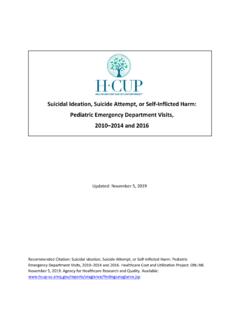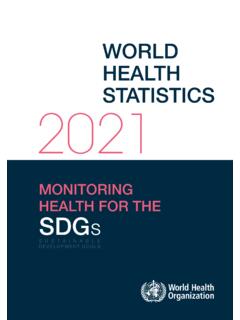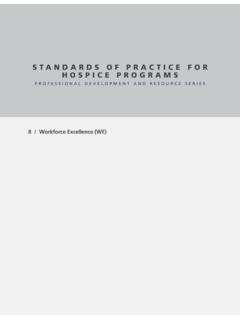Transcription of ALL PATIENT REFINED DIAGNOSIS RELATED GROUPS (APR …
1 ALL PATIENT REFINEDDIAGNOSIS RELATED GROUPS (APR-DRGs)Version Overview3M Health Information SystemsRichard F. AverillNorbert Goldfield, S. Hughes, BonazelliElizabeth C. McCulloughBarbara A. SteinbeckRobert Mullin, M. TangNational Association of Children s Hospitalsand RELATED Institutions, MuldoonLisa TurnerMedical Advisory Committee for NACHRI APR-DRG Research ProjectJames Gay, iiCopyright 2003, 3M. All rights Health Information Systems has prepared this document for use only by 3M HIS per-sonnel and 3M customers who have executed an Order Agreement. This document, and the information contained within, are confidential and proprietary to 3M, and may not be used, copied, reproduced, stored in a retrieval system or transmitted in whole or in part without the prior written permission of 3M.
2 No permission is granted for this document, or an portion of this document, to be disclosed to, or used by, any party other than the 3M customer to whom this document is delivered by 3M HIS. It is the policy of 3M Health Information Systems to improve products as new technology and software become available. Because of this, 3M HIS reserves the right to make changes in the specifications and materials contained herein without HIS shall not be liable for any direct, indirect, special, consequential, or other dam-ages or economic loss arising out of any use of, errors in using, or inability to use this product includes commercial technical data and/or computer databases and/or com-mercial computer software and/or commercial computer software documentation, which were developed exclusively at private expense by 3M Company, 575 West Murray Boule-vard, Murray, Utah 84123 4611.
3 Government rights to use, modify, reproduce, release, perform, display, or disclose these technical data and/or computer databases and/or computer software and/or computer software documentation are subject to the lim-ited rights restrictions of DFARS 7015(b)(2) (June 1995) and/or subject to the restrictions of DFARS 1(a) (June 1995) and DFARS 3(a) (June 1995), as applicable for Department of Defense procurements and the limited rights restrictions of FAR 14 (June 1987) and/or subject to the restricted rights provi-sions of FAR 14 (June 1987) and FAR 19 (June 1987), as applicable, and any applicable agency FAR Supplements, for non-Department of Defense Federal procurements. 3M Health Information Barnes RoadWallingford, CT 06492(203) 949 0303 For product information, call 1 800 367 2447 For customer support, call 1 800 435 7776 This manual was written, designed, and produced by the Clinical Research and Docu-mentation Departments of 3M Health Information Systems, Wallingford, Connecticut and Murray, number GRP 041 Version 07/03iiiACKNOWLEDGEMENTSThe developement of the APR-DRGs, Version , involved the participation of many individual contributors.
4 3M HIS consultants Ruth Shaber, , Warren Strauss, , Stephen Wittenberg, , David Earle, , James Flink, , James Slaughter, , Robert Keller, , Donald George, , and Benjamin Gitterman, provided clinical input into the research. Data analysis support for the project was provided by Keith C. Mitchell, Enes Elia, Mona Bao, Julie-Anne Perry, and Oleg Kostenko. The software was produced by Ronald Mills and Laurence W. Gregg. It was tested by Susie Nickman and Carolyn Hogan. Assistance in the design and production of the APR-DRG Definitions Manual was provided by Sue Boucher, Kathy Blake, Marilyn Marino, and Darriell Rolka. ivvTable of ContentsCHAPTER 1 HISTORY OF THE DEVELOPMENT OF THE DIAGNOSIS RELATED GROUPS (DRGS).
5 1 CHAPTER 2 DEVELOPMENT OF THE ALL PATIENT REFINED DIAGNOSIS RELATED GROUPS (APR-DRGS) .. 19 CHAPTER 3 BACKGROUND AND EXPLANATION OF APPROACH FOR REROUTING LOGIC IN APR-DRG, VERSION .. 57 APPENDIX ALIST OF ALL PATIENT REFINED DRGS, VERSION .. 69viCHAPTER 11 History of the Development of the DIAGNOSIS RELATED GROUPS (DRGs)23 HISTORY OF THE DEVELOPMENT OF THE DIAGNOSIS RELATED GROUPS (DRGS)Background The DIAGNOSIS RELATED GROUPS (DRGs) are a PATIENT classification scheme which provides a means of relating the type of patients a hospital treats ( , its case mix) to the costs incurred by the hospital. There are currently three major versions of the DRG in use: basic DRGs, All PATIENT DRGs, and All PATIENT REFINED DRGs.
6 The basic DRGs are used by the Centers for Medicare and Medicaid Services (CMS) for hospital payment for Medicare beneficiaries. The All PATIENT DRGs (AP-DRGs) are an expansion of the basic DRGs to be more representative of non-Medicare pop-ulations such as pediatric patients. The All PATIENT REFINED DRGs (APR-DRG) incorporate severity of illness subclasses into the AP-DRGs. Since the APR-DRGs include both the CMS DRGs and the AP-DRGs, the development of all three versions of the DRGs will be design and development of the DRGs began in the late sixties at Yale University. The initial motivation for developing the DRGs was to create an effective framework for monitoring the qual-ity of care and the utilization of services in a hospital setting.
7 The first large-scale application of the DRGs was in the late seventies in the State of New Jersey. The New Jersey State Depart-ment of Health used DRGs as the basis of a prospective payment system in which hospitals were reimbursed a fixed DRG specific amount for each PATIENT treated. In 1982, the Tax Equity and Fis-cal Responsibility Act modified the Section 223 Medicare hospital reimbursement limits to include a case mix adjustment based on DRGs. In 1983 Congress amended the Social Security Act to include a national DRG-based hospital prospective payment system for all Medicare patients. The evolution of the DRGs and their use as the basic unit of payment in Medicare s hospital reim-bursement system represent a recognition of the fundamental role which a hospital s case mix plays in determining its costs.
8 In the past, hospital characteristics such as teaching status and bed size have been used to attempt to explain the substantial cost differences which exist across hos-pitals. However, such characteristics failed to account adequately for the cost impact of a hospital s case mix. Individual hospitals have often attempted to justify higher cost by contending that they treated a more complex mix of patients. The usual contention was that the patients treated by the hospital were sicker. Although there was a consensus in the hospital industry that a more complex case mix results in higher costs, the concept of case mix complexity had histori-cally lacked a precise definition. The development of the DRGs provided the first operational means of defining and measuring a hospital s case mix complexity.
9 The concept of case mix complexity The concept of case mix complexity initially appears very straightforward. However, clinicians, administrators and regulators have often attached different meanings to the concept of case mix complexity depending on their backgrounds and purposes. The term case mix complexity has been used to refer to an interrelated but distinct set of PATIENT attributes which include severity of illness, risk of dying , prognosis, treatment difficulty, need for intervention, and resource intensity. Each of these attributes has a very precise meaning which describes a particular aspect of a hos-pital s case of Illness. Refers to the extent of physiologic decompensation or organ system loss of of Mortality.
10 Refers to the likelihood of dying . Prognosis. Refers to the probable outcome of an illness including the likelihood of improvement or deterioration in the severity of the illness, the likelihood for recurrence, and the probable life span. 4 Treatment Difficulty. Refers to the PATIENT management problems which a particular illness pre-sents to the health care provider. Such management problems are associated with illnesses without a clear pattern of symptoms, illnesses requiring sophisticated and technically difficult pro-cedures, and illnesses requiring close monitoring and supervision. Need for Intervention. Relates to the consequences in terms of severity of illness that lack of immediate or continuing care would produce.










